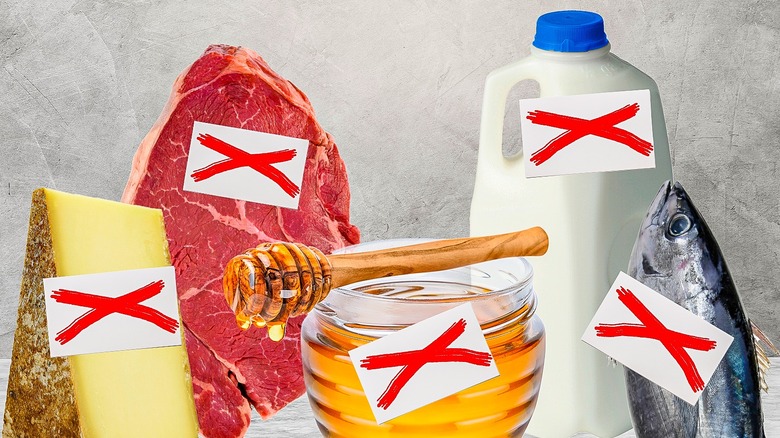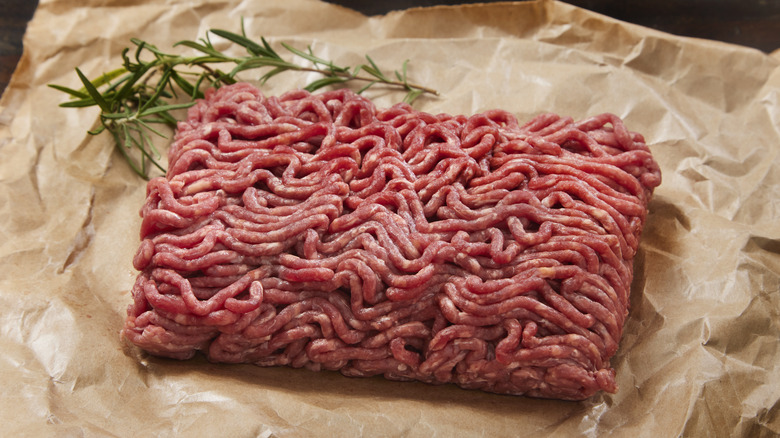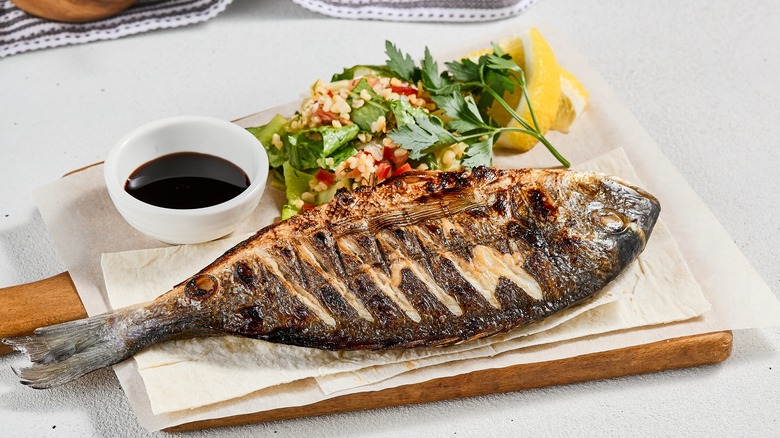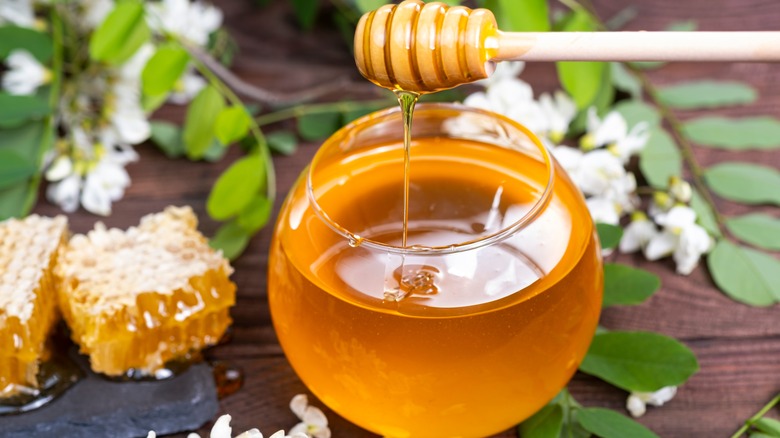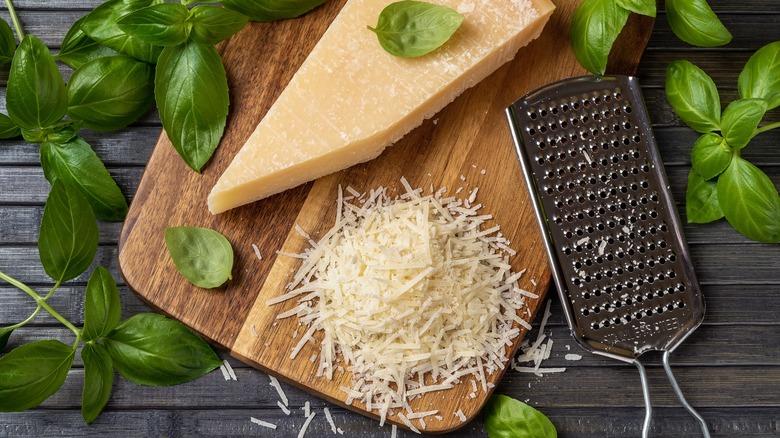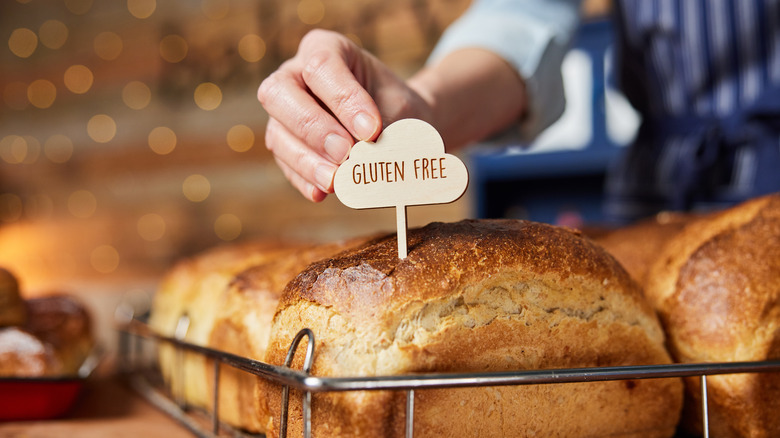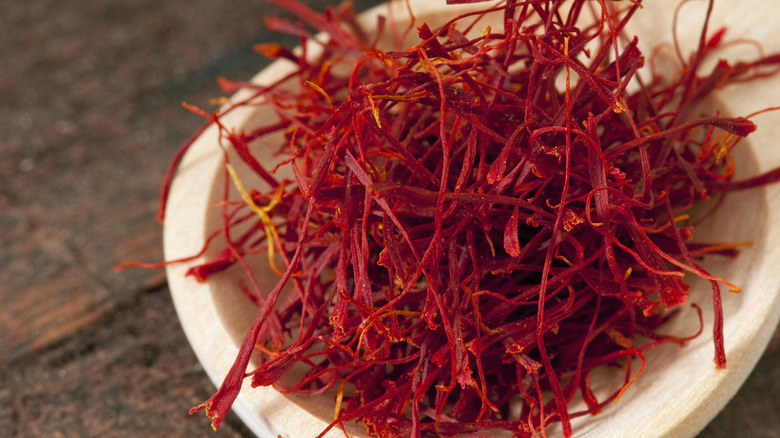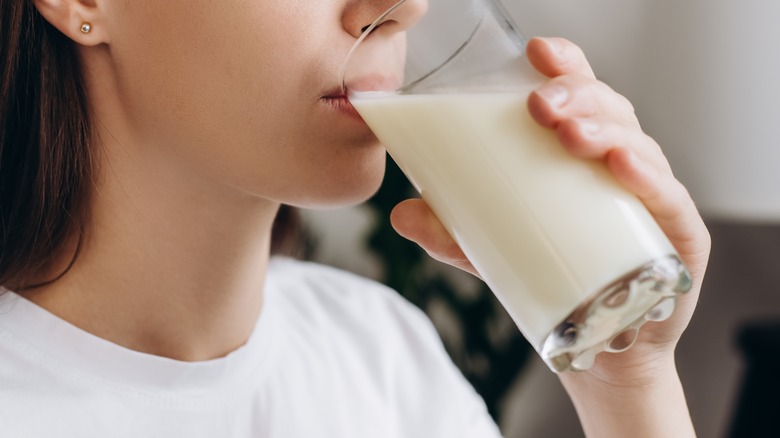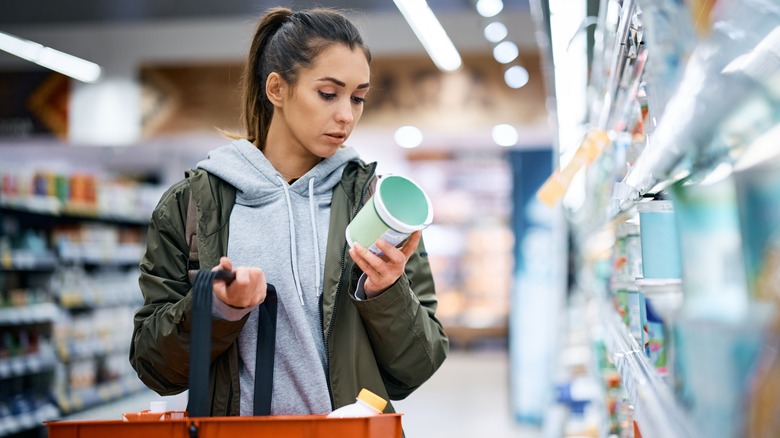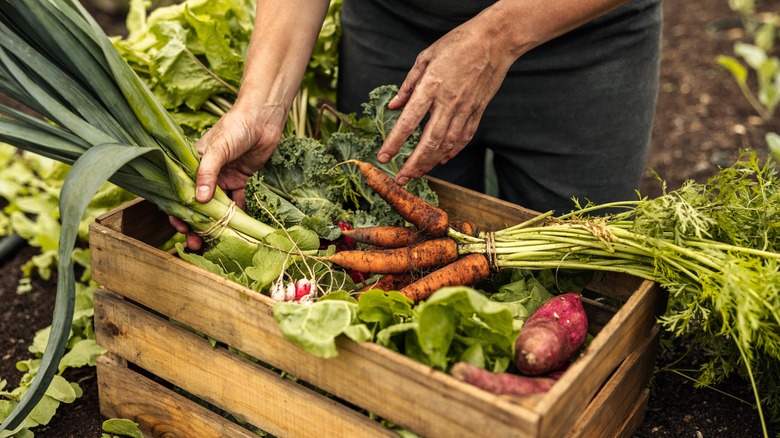Foods That Are Commonly Mislabeled
How often do you think about whether the information on the labels of your favorite foods is actually true? Probably not that often if you're like most people. Consumers tend to assume that food manufacturers are on the up and up and that they're getting exactly what's printed on the box, can, bag, or plastic wrap. Unfortunately, they're often not.
In some cases, mislabeling is a quality control failure, but more often it's fraud — manufacturers trying to pull the wool over consumers' eyes for profit. Food fraud is surprisingly rampant, accounting for an estimated 10% of all commercial foods and costing the global food industry billions of dollars every year, according to the Congressional Research Service. Some of the biggest offenders are foods you probably eat at least a couple of times a week: meat, fish, and cheese. Honey, wine, herbs and spices, and organic foods are other common culprits. And watch out for foods labeled sugar- and gluten-free — they may have some unexpected ingredients.
Not only does mislabeled food mean you're not getting the value you paid for, but it can also negatively affect your health. Although there's no surefire way to detect mislabeled food, you can take steps to make better choices next time you're at the market.
Meat
In a 2015 study, 57% of the meat products researchers tested were found to have meat from other animals than what was printed on the label. Chicken sausage contained pork and beef, pork sausages had beef, and pork pâté had chicken. In 2021, Belcampo Meat Co., a high-end chain of butcher shops and restaurants selling sustainably farmed organic meats, quickly shut down all of its locations after it was discovered the company was mislabeling products sold at its Santa Monica store. A former employee revealed that lower quality meats, some factory farmed, were being purposefully mislabeled and passed off as the higher quality meats the company was known for — and for the same price. In Europe in 2013 a major scandal swept the food industry when horsemeat was found in beef products throughout the continent. A beef burger from Tesco, a major European supermarket chain, was found to contain 29% horsemeat.
These are just a sample of the ways that consumers get tricked at the meat counter every day. While the usual advice to avoid food fraud is to shop for meat at reputable retailers, the Belcampo scandal shows even that may not be enough to avoid mystery meat.
Fish
If you were thinking of giving up meat and hopping over to the seafood counter, you won't have any better luck with transparency there. Fish fraud may be an even more widespread problem than mislabeled meat. Testing by the FDA showed that 15% of fish was labeled incorrectly. A global research analysis by Guardian Seascape found that 36% of the seafood samples were mislabeled. Fish were labeled as other closely related species of lesser value. Less-prized Japanese scallops were labeled as king scallops, and cheaper varieties of shark filets were labeled as more expensive species. They even found vulnerable or endangered species being used as substitutes.
The problem is the vastness and complexity of the global seafood industry, which creates numerous opportunities for mislabeling. Fish fraud is also rampant in restaurants. One study found that 1 out of 3 samples from restaurants was not what it was labeled as. Spain, Finland, Iceland, and Germany had restaurant mislabeling rates as high as 50%.
Premium seafood — at the market and in a restaurant — can be quite an investment, so you want to be sure you're getting what you paid for. But it's not just your wallet that takes a hit — fish fraud hampers marine conservation efforts and can have negative effects on human health. Again, eating more plant foods is a viable strategy for avoiding catfish on your plate instead of the Chilean sea bass you ordered. It's hard to mistake Brussels sprouts for anything other than Brussels sprouts.
Honey
Did you hear the buzz? Honey is one of the top frraudulent foods on the market. In fact, honey was the subject of the biggest incident of food fraud in United States history in 2013, when two major honey importers skirted $180 million in import duties on large shipments of honey from China by declaring it as a different commodity. Not only that — some of the honey was found to be adulterated with the antibiotic chloramphenicol, which has not been declared safe for human consumption by the FDA.
In a 2018 study, researchers tested 100 honey samples from 19 countries and found 27% of them to be potentially fake. Instead of containing pure honey, as stated on the labels, they were found to be adulterated with other sugary substances including cane sugar and corn syrup. And, just recently, the Joint Research Centre (JRC) and the Anti-Fraud Office (OLAF) uncovered major honey fraud when their research revealed that almost 50% of randomly selected honey samples were adulterated with wheat, sugar beet, or rice syrups (via Forbes).
Not only is fake imported honey bad for consumers, but it's also bad for domestic producers who have seen a steady decline in sales as imports increase (via the Congressional Research Service). One thing you can do to avoid fake honey is to buy honey made in the U.S. Even better, buy direct from local producers to support your local economy.
Cheese
Cheese lovers will be devastated to discover their beloved Parmesan contains wood shavings and that their prized Swiss wasn't actually made in Switzerland. Those are examples of ways falsified food labels can mislead at the cheese counter.
In 2016, the FDA found that Parmesan cheeses labeled 100% Parmesan may not be what they claim. The president of the Castle Cheese company was found guilty of marketing 100% fake Parmesan cheese for nearly three decades. And that's no isolated occurrence — an estimated 20% of hard Italian cheeses may be mislabeled. In a Bloomberg experiment, many store-bought grated Parmesan cheeses were found to contain wood pulp, including Walmart and Whole Foods store brands. To fight fraud, Parmesan producers are embedding miniature scannable trackers in the rinds of cheese wheels. Don't worry — they're food-safe and so small you won't even be able to spot them.
Many Swiss producers of Emmentaler are fighting fraud as well. Authentic Emmentaler, or Swiss cheese, is produced in the Emmentaler region of central Switzerland using raw milk from grass-fed cows. Cheese counterfeiters often pass off inferior products made of lower-quality ingredients as the real thing — to the detriment of consumers and Swiss producers who lose millions of dollars in sales. Experts have started cracking down on counterfeits in Europe and the U.S. using DNA testing. Swiss cheese lovers should do their research to find out if their favorite brand is for real.
Gluten-free foods
There are two types of gluten-free shoppers — those who believe that gluten-free foods are somehow healthier than other foods and those who have a gluten intolerance or allergy. Gluten-free products are typically more expensive than gluten-containing products, but this is more than worth it for people with a gluten intolerance or allergy, who can become very sick after eating even a small amount of gluten.
Scores of products labeled as gluten-free have been reported by consumers and third-party testing to contain gluten ingredients. Examples include tea containing barley, sprinkles containing wheat-derived malt extract, and popcorn containing malted barley, wheat, and hydrolyzed wheat gluten are just a few examples. The FDA has stepped in to help, but there's only so much it can do. Consumers have to be informed so they at least know hidden ingredients that may contain gluten, such as malt extract and wheat-derived soy sauce. Unfortunately, there's nothing consumers can do if a gluten-containing ingredient is purposefully or accidentally left off the label; however, you can keep up to date on reports of contaminated foods by regularly checking online sources, such as Gluten Free Watchdog's list of potentially mislabeled foods.
Wine
How much do you know about what's in your wine? It says French Bordeaux, but unless you're a master sommelier, how can you be sure it's not California merlot? Cases of mislabeled wine are rampant, and they cost the wine industry billions of dollars. Sometimes it's an honest mistake, as was the case for Australian wine producers who thought they were growing a particular French grape called Petit Mesang when in fact they were cultivating a variety called Gros Mesang.
That mishap didn't have much of an impact on the wine industry or consumers. Not so for cases like the class action suit against a California winemaker who falsified the origin of his pinot noir, giving the impression it was produced in the prized Oregon wine region. This allowed him to mark up the bottles and increase his profits. In another case, French winemaker Vincent Lataste was sentenced to a year in prison for exceeding the allowable limits of sulfur dioxide in his wine. Wines contain low levels of this compound to control bad bacteria and yeast, but higher amounts may be used to disguise an older oxidized wine as a younger wine. Lataste was also found to have added water to wine, mixed different wines, and mislabeled the year and origin on bottles.
Herbs and spices
Variety is the spice of life, but depending on which variety you choose, your spice might not be all it's supposed to be. Because of its high price tag — as much as $5,000 per pound — saffron is frequently the target of counterfeiters looking to make a buck off unsuspecting retailers and consumers. The spice may be adulterated with other, considerably cheaper, plant-derived substances such as calendula, safflower, turmeric, and gardenia, while the packaging states the product is 100% pure (via the National Institutes of Health). According to a 2022 study, less than 50% of the saffron sold in India is completely authentic.
Sage is another one to watch. Researchers at Queens University Belfast tested 19 samples and found that more than a quarter of them were adulterated. Olive tree leaves and other tree leaves were used to add bulk to sage, in some cases replacing nearly 60 percent of the genuine article. Although the substances used were not thought to pose a safety risk, the inferior product quality is certainly cause for concern.
That's not to say you shouldn't worry. There may, in fact, be hazardous substances hiding in your herbs and spices that aren't listed on the label. Consumer Reports tested 126 brands of herbs and spices and found that 40 of them contained potentially dangerous levels of heavy metals, including lead, arsenic, and cadmium. Levels were high enough that one normal serving size could pose a risk to children — and even adults.
Milk
Sales of non-dairy milk are predicted to exceed $34 billion in 2023 and reach almost $59 billion by 2027, according to GlobeNewswire. Almond, oat, soy, and coconut milks are the biggest sellers. And the newest non-dairy milk substitute on the horizon isn't even grown — it's made in a lab. Synthetic milk contains the same proteins found in milk — casein and whey — but they are genetically engineered from yeast and contain no animal products.
This has the dairy industry up in arms over claims of milk mislabeling and "fake milk." The FDA defines milk as something that comes from an animal, but it doesn't say that other substances can't be labeled as milk. Dairy producers have called for the FDA to redefine milk and prohibit non-animal-based beverages from labeling themselves as milk.
However, the FDA ruled in May 2023 that plant milks may still be labeled as milk (via CBS News). It also said that plant milks aren't pretending to be from animals and that consumers are clear about what plant milk is. The FDA did call for additional, voluntary labeling on the part of plant milk manufacturers. This new labeling would communicate if the particular product had lower levels of certain nutrients, such as vitamin D, magnesium, and calcium as compared to dairy milk.
Sugar-free foods
It's good to read labels and reduce your intake of sugar. But it's hard to know what you're looking at most of the time when it comes to sugar-free foods. With claims like "no sugar added" and "0 grams sugar," you might automatically think they're low calorie and good for you. That's what some California consumers complained of in a class action lawsuit against major brands Campbell's and Pepperidge Farm. They claimed that foods marketed by these brands are mislabeled because they say "0 grams sugar" but do not also disclose that the product is not a low-calorie food.
Many foods labeled as "no sugar added" still contain naturally occurring sugar — sometimes a lot of it. Orange juice, even if it has no sugar added, still has basically the same number of calories and almost as much sugar as soda. Yes, it's naturally occurring and comes along with other naturally occurring nutrients, but it's still not sugar-free or low-calorie. Consumers may get tricked by that lack of transparency, and for people with diabetes and other medical conditions that require them to limit sugars — natural or added — that could come at a cost to their health (via Diabetes UK).
Sugar-free also doesn't mean it's not sweetened. Many sugar-free products contain sugar alcohols such as maltitol, a carbohydrate that still has calories and affects blood sugar (via Healthline). It can also have gastrointestinal side effects including bloating, gas, and diarrhea.
Organic foods
Organic foods are considerably more expensive than conventional foods, and a lot of times it's for good reason. Organic foods are usually more sustainable, have higher animal welfare standards, are produced in smaller amounts, and have higher production costs. But how do you know what you're paying a premium for is actually organic? As of 2015, there were approximately 24,000 certified organic producers in the U.S. but only 80 agencies making sure they were meeting the USDA's standards. With so little oversight, it's hard to trust that everyone is following the rules.
Farmers do have their certifications revoked on the off chance that they're one of a small percentage of farms subject to surprise inspection. Some even get the book thrown at them, as was the case with a pair of South Dakota grain farmers who scammed more than $70 million out of consumers buying their mislabeled "organic" grains.
It's not just the producers that are the problem. Middlemen can pull the wool over our eyes as well. Another South Dakotan scored $71 million by buying conventional grains and seeds and marketing them as organic. Organic fraud can indirectly affect the consumer, too. A Missouri grain salesman sold mislabeled grains to be used as feed for livestock on farms producing organic meat and chicken.
Pet Food
Pets are the new kids, and furparents want to make sure their babies get the best money can buy. Unfortunately, with rampant mislabeling in the pet food industry, you can't always be sure what you're buying. Foods either don't contain the ingredients listed on the label or contain additional ingredients not listed on the label. For example, Chapman University researchers tested 52 samples of pet food and found that only 31 of them were correctly labeled. The rest of them contained meats not listed on the label — most frequently pork — or did not contain a meat ingredient they purported to include. One of them contained a meat ingredient that couldn't be identified.
But when it comes to pets, meat is meat, right? Not if you're paying a premium for venison and getting plain old chicken. The bigger problem is that foods formulated for specific health needs, such as an allergy to chicken, may contain ingredients that can cause a pet to become sick. Although only laboratory tests can reveal what's really in your pet's food, you can stay abreast of the latest pet food recalls by frequently checking the FDA's recalls and withdrawals list.
